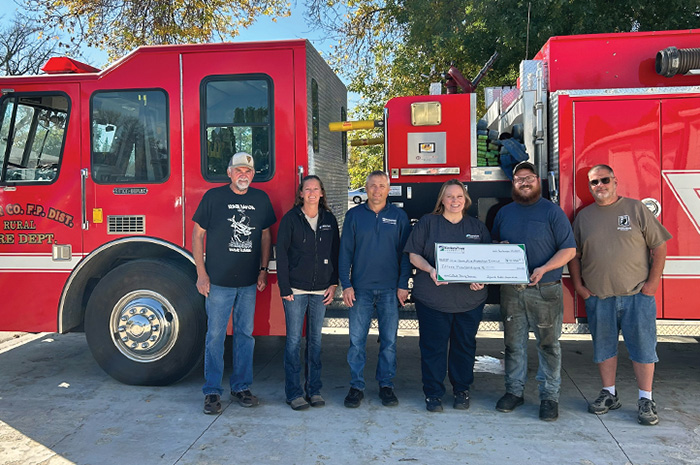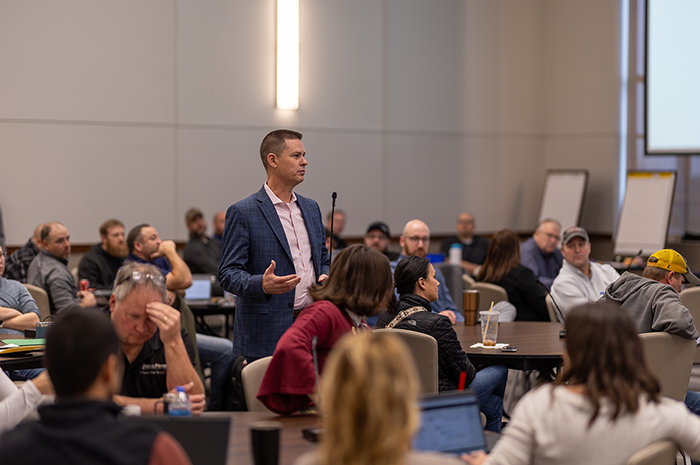Painting the town blue
Roseau Electric Cooperative member Polaris Inc. is finding efficiencies with its new robotic painting system.
Kelli Simon has an uncommon job at Polaris Inc. in Roseau, Minnesota. She manages a new addition to the powersports equipment manufacturing facility, a state-of-the-art system that sits at the intersection of art, technology and off-road action.
Simply said – Simon works with painting robots.
“This is where you’ll notice they go from raw to color,” she said, looking through glass to the snowmobile rails being sprayed flawlessly by a hulking robotic arm. “It looks like we’re painting ‘sports equipment black.’”

Polaris broke ground for its new 28,000-square-foot robotic liquid paint application expansion in 2022, a $22 million investment to support the company’s continued growth while also improving energy efficiency and reducing waste. Already, just a year and a half since the painting line began to roll, Simon and her team have experienced a rainbow of benefits.
“If you ever saw the old paint system, we have about twice the capacity in this system,” she explained. “It’s a great efficiency gain overall for both us and throughput, all in support of what we’re seeing – the rising demand in customer need and variations in what we can offer across all of our platforms.”
High tech, low waste
Roseau is the birthplace of Polaris, which took root there in 1954. Since then, Polaris’ Roseau facility has grown to a footprint of 828,000 square feet, with four assembly lines producing all-terrain vehicles, snowmobiles and military vehicles.
Painting parts has always been part of the process, but it’s looked different over the decades. While the industry lifespan of a paint system is typically 12-15 years, Polaris was able to use its last setup for 34 years because of the committed care and maintenance provided by employees.

On the new painting line, plastic parts are robotically flame treated to create smoother edges and surfaces and, in the case of nylon-based plastic, to open the pores to allow the paint to better adhere.
“That’s a big quality improvement,” Simon said. “It used to be a fully manual project with a man with a torch. So, from a safety standpoint, we’ve eliminated flame throwers in people's hands, but it has also created a lot of consistency.”
After the parts move through the flame cell, they are washed of any dirt or dust and rinsed with reverse-osmosis water (generated in house). They are moved through an oven to dry, then travel an open-air loop of the facility to allow them to cool to below 100 degrees.
At that point, the parts are ready to meet the robotic painting team – one primer for the aluminum parts that need it, two base coat robots to apply an array of 26 colors and two robots in charge of clear coat.

“Clear coat is where we get a little fun. You can take it from a gloss part to a matte part. We can also add what we call mid coats, or pearls, or metallic,” Simon said. “If you look at our high-quality paint jobs, sometimes it can look almost three dimensional. That's added with the different layers.”
With the previous painting system, paint would be fully mixed before running through 60 feet of tubing to arrive at the paint gun. With the new system, paint is mixed just before it hits the robot, meaning only six feet of tubing needs to be cleaned out instead of 60 feet. The change not only reduces what is needed to paint a part, but it also reduces waste.

“The goal, when you make an investment like this, is to get your return on investment as soon as possible,” Simon said. “It’s a huge investment into not only Polaris, but also into Roseau.”
Empowering powersports
Roseau Electric Cooperative (REC) has been a Polaris power partner from the start, enhancing electric service for facility expansions and helping leadership find energy efficiencies and savings in their blueprints. In the case of the robotic paint facility, REC was able to deliver a $50,000 PowerSavers rebate check to Polaris for its new electric chiller, which will help the cooperative meet its annual energy savings goal set by the state of Minnesota.
“It’s always been a great relationship,” REC General Manager Ryan Severson said of Polaris, which is the rural co-op’s largest commercial load. “We sit down with them at least twice a year to visit and discuss any projects they may have on the horizon.”

REC was one of many community partners that made the robotic paint expansion a reality. Many of the contractors and vendors involved in the project were from the area and, with the decades of total paint and technology expertise already on the Polaris team, the development and implementation was streamlined. “We’ve been able to leverage our local contacts that we trust and have existing relationships with. We’ve built this whole place together,” Simon said.
In a community of fewer than 3,000 people, around 1,500 are employed by Polaris. And that certainly paints a picture of the synergy built between Roseau and the innovators blazing trails through mud and snow.
“The people here are invested not only in Roseau, but they're invested in Polaris. They've seen it build and grow. Polaris itself is 70 years old, and a lot of our people have been here 35 or 40 years,” Simon said. “That's a testament to not only Roseau, but to the company, and the investment back and forth with the community.”

...



